Microplastics are small, practically indestructible fragments shed by ordinary plastic items. The news becomes worse as more information regarding microplastics becomes available. Microplastics are known to exist in soil, seas, and even the most unlikely places—the arteries, lungs, and placenta.
 Particle counts of petroleum-based (EVA) and plant-based (TPU-FC1) microplastics show that, over time, EVAs exhibit virtually no biodegradation, while the TPUs have mostly disappeared by day 200. Image Credit: University of California San Diego
Particle counts of petroleum-based (EVA) and plant-based (TPU-FC1) microplastics show that, over time, EVAs exhibit virtually no biodegradation, while the TPUs have mostly disappeared by day 200. Image Credit: University of California San Diego
It can take up to 1,000 years for microplastics to decompose, and in the interim, their daily presence in the human body and planet increases.
It is more crucial than ever to find sustainable substitutes for microplastics and conventional plastics derived from petroleum. According to a recent study, plant-based polymers produced by Algenesis and experts at the University of California, San Diego, biodegrade in less than seven months, even at the microplastic level. The report is published in Nature Scientific Reports and was written by professors, alumni, or former research scientists at UC San Diego.
We are just starting to understand the implications of microplastics. We have only scratched the surface of knowing the environmental and health impacts. We are trying to find replacements for materials that already exist and make sure these replacements will biodegrade at the end of their useful life instead of collecting in the environment. That's not easy.
Michael Burkart, Study Author and Professor, University of California, San Diego
Another of the study’s authors, Robert Pomeroy, who is also a professor of chemistry and biochemistry and an Algenesis co-founder, added, “When we first created these algae-based polymers about six years ago, our intention was always that it be completely biodegradable. We had plenty of data to suggest that our material was disappearing in the compost, but this is the first time we have measured it at the microparticle level.”
Putting it to the Test
The group pulverized its product into small microparticles to assess its biodegradability. They then utilized three distinct measurement tools to determine that when placed in compost, the material was being digested by bacteria.
A respirometer was the first tool. The respirometer detects carbon dioxide (CO2), which is released by the microorganisms during the breakdown of compost material. The breakdown of cellulose, regarded as the industry benchmark for 100% biodegradability, was contrasted with these findings. Nearly 100% of the cellulose was matched by the plant-based polymer.
The group then employed water flotation. Plastics are readily removed from the water's surface since they float and are not soluble in water. Nearly all petroleum-based microplastics were collected at intervals of 90 and 200 days, indicating that none had biodegraded.
However, just 32% of the microplastics made of algae were found after 90 days, indicating that more than two-thirds had biodegraded. Only 3 percent was found after 200 days, indicating that 97% had vanished.
Using gas chromatography/mass spectrometry (GCMS) for chemical analysis, the last measurement revealed the presence of the plastic’s monomers, a sign that the polymer was breaking down into its starting plant components. Further evidence of how microorganisms colonize biodegradable microplastics during composting came via scanning electron microscopy.
This material is the first plastic demonstrated to not create microplastics as we use it. This is more than just a sustainable solution for the end-of-product life cycle and our crowded landfills. This is actually plastic that is not going to make us sick.
Stephen Mayfield, Study Co-Author and Professor, University of California, San Diego
Developing an environmentally benign alternative to petroleum-based polymers is one step along the long path to viability. The ongoing challenge is to employ the new material on pre-existing production equipment designed for traditional plastic, and Algenesis is making progress.
They have collaborated with numerous companies to create products that employ the plant-based polymers discovered at UC San Diego, including Trelleborg for coated textiles and RhinoShield for cell phone cases.
Burkart added, “When we started this work, we were told it was impossible. Now we see a different reality. There is a lot of work to be done, but we want to give people hope. It is possible.”
Robert S. Pomeroy, Michael D. Burkart, Steven P. Mayfield (all UC San Diego), Marco N. Allemann, Marissa Tessman, Jaysen Reindel, Gordon B. Scofield, Payton Evans, Ryan Simkovsky (all Algenesis) are the other study authors.
This study was funded by the Department of Energy (DE-SC0019986 and DE-EE0009295).
Journal Reference:
Allemann, M. N., et. al. (2024) Rapid biodegradation of microplastics generated from bio-based thermoplastic polyurethane. Scientific Reports. doi:10.1038/s41598-024-56492-6